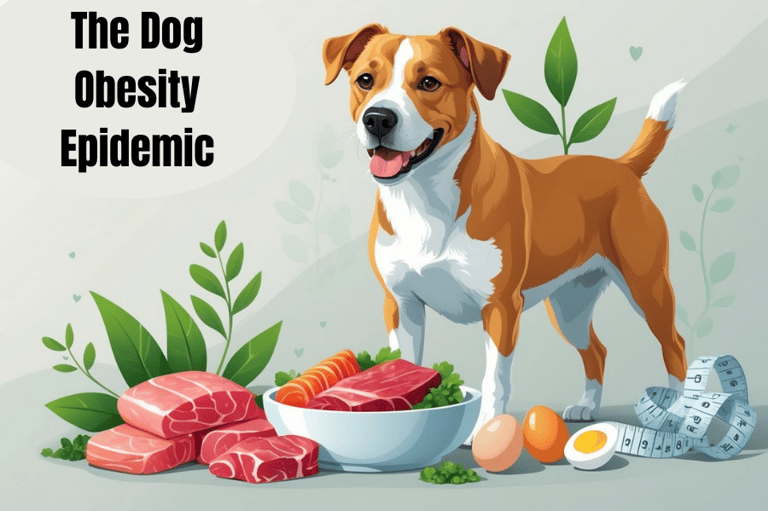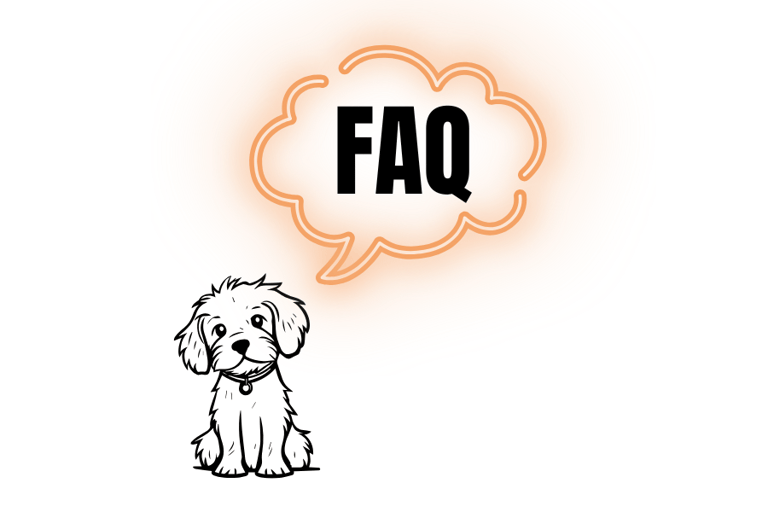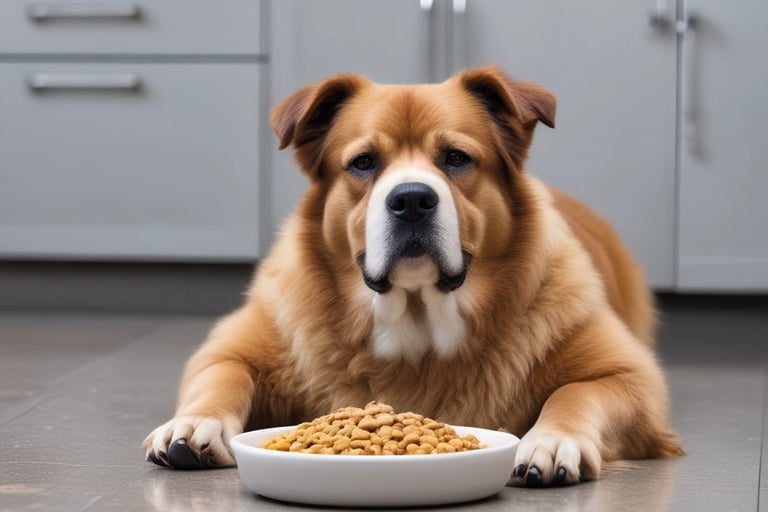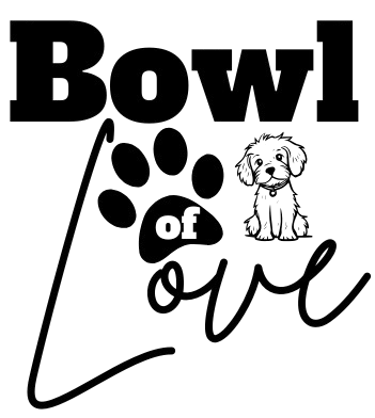The Obesity Epidemic in Dogs
A Growing Health Crisis Every Pet Owner Should Know About
DOG NUTRITION TIPS
10/1/20257 min read
The Obesity Epidemic in Dogs
At Bowl of Love, we sometimes recommend trusted products. If you choose to purchase through our links, we may earn a small commission at no additional cost to you. Thank you for supporting our mission to bring healthier food choices to dogs everywhere.
Dog obesity has become a serious health crisis affecting pets across the country. Approximately 60 percent of dogs are now overweight or obese, making it the most common health problem in canine medicine today. This growing epidemic mirrors human obesity rates and poses significant risks to dogs' health and lifespan.
Many pet owners don't realize their furry companions are carrying extra weight until serious health problems develop. Obesity can lead to diabetes, arthritis, and shorter lifespans for beloved pets. The good news is that this condition is entirely preventable with the right approach to nutrition and lifestyle.
An animal-based diet offers a natural solution to help dogs maintain healthy weights while providing the nutrition their bodies were designed to process. Understanding the causes behind this epidemic and learning practical prevention strategies can help pet owners take control of their dog's health before problems arise.
Understanding the Obesity Epidemic in Dogs
Dog obesity has reached alarming levels across North America, with 25-30% of dogs classified as obese and even more falling into the overweight category. This condition develops gradually through multiple factors including diet, exercise habits, and owner lifestyle choices.
Prevalence of Canine Obesity
The numbers tell a concerning story about pet health today. Over 50% of pets in the U.S. are overweight or obese, making this condition extremely common.
Among dogs specifically, 40-45% of those aged 5-11 years are overweight. This age group faces the highest risk for weight problems.
The issue affects dogs throughout their adult lives. Weight problems peak during the mature life stage in dogs, when metabolism slows and activity levels often decrease.
Age-Related Weight Patterns:
Puppies: Lower risk
Adult dogs (5-11 years): Highest risk group
Senior dogs: Continued elevated risk
Obesity ranks as the most common nutritional disorder in pet dogs. This makes it more widespread than vitamin deficiencies or other dietary issues.
Recognizing Signs and Symptoms
Dog owners can spot weight problems through simple visual and physical checks. A healthy dog should have a visible waist when viewed from above and from the side.
Physical Signs to Watch For:
Ribs: Hard to feel under a layer of fat
Waist: No visible tuck behind the ribcage
Neck: Fat deposits around the collar area
Face: Rounded cheeks or double chin appearance
Overweight dogs often show behavioral changes too. They may tire easily during walks or play sessions. Many prefer lying down instead of standing or moving around.
Movement Changes:
Reluctance to climb stairs
Heavy breathing after light activity
Difficulty jumping onto furniture
Slower walking pace
Some dogs develop a waddling gait when walking. Their belly may swing from side to side or hang low. These movement patterns indicate excess weight affecting their mobility.
Factors Contributing to Weight Gain
Multiple factors work together to cause weight gain in dogs. Dogs maintained on highly nutritious diets with lower exercise face positive energy balance, meaning they consume more calories than they burn.
Primary Contributing Factors:
Overfeeding or large portion sizes
High-calorie treats and table scraps
Reduced physical activity levels
Slower metabolism with age
Owner habits play a major role in pet weight. Studies show that both the weight and health of owners influence their dogs' eating habits and physical activity.
Less active owners often have less active pets. Dogs mirror their family's lifestyle patterns in many ways.
Lifestyle Factors:
Indoor living with limited outdoor access
Busy schedules reducing walk time
Using food as primary reward method
Multiple family members feeding the same dog
Certain breeds face higher obesity risks due to genetics. Breeds like Labrador Retrievers, Beagles, and Cocker Spaniels show greater tendencies toward weight gain than others.
Preventing Dog Obesity with an Animal-Based Diet
Animal-based diets provide high-quality protein that helps dogs maintain lean muscle mass while losing excess weight. Proper portion control and regular exercise work together with quality nutrition to keep dogs at their ideal weight.
Nutritional Benefits of Animal-Based Foods
Animal-based proteins offer complete amino acid profiles that plant proteins cannot match. These proteins help dogs feel full longer, reducing the urge to overeat between meals.
High-quality animal proteins include:
Chicken and turkey
Beef and lamb
Fish like salmon and sardines
Eggs
These foods have higher protein content per calorie than plant-based options. This means dogs get more nutrition without extra calories that lead to weight gain.
Animal fats provide essential fatty acids that support healthy skin and coat. They also help dogs absorb important vitamins like A, D, E, and K.
Raw or minimally processed animal foods retain more nutrients than heavily processed kibble. This helps dogs get better nutrition from smaller portions.
Creating a Balanced Feeding Routine
Proper feeding practices prevent obesity better than free-choice feeding. Scheduled meals help control exactly how much food dogs eat each day.
Daily feeding schedule:
Puppies: 3-4 small meals
Adult dogs: 2 meals
Senior dogs: 2 smaller meals
Measure food portions using a kitchen scale instead of cups. This gives exact amounts and prevents accidental overfeeding.
Most adult dogs need about 2-3% of their ideal body weight in food daily. A 50-pound dog should eat roughly 1-1.5 pounds of food per day.
Remove food bowls after 15-20 minutes, even if not empty. This teaches dogs to eat at meal times instead of grazing all day.
Exercise and Lifestyle Tips
Regular exercise helps prevent obesity by burning calories and building muscle mass. Dogs need both physical activity and mental stimulation to stay healthy.
Daily exercise requirements:
Small dogs: 30-60 minutes
Medium dogs: 60-90 minutes
Large dogs: 90-120 minutes
Walking, swimming, and playing fetch burn calories effectively. Start slowly with overweight dogs to avoid injury.
Mental activities like puzzle toys and training sessions also burn energy. These activities keep dogs busy and reduce boredom eating.
Interactive feeding toys make dogs work for their food. This slows down eating speed and provides mental exercise at meal time. (We highly recommend this slow feeder from Amazon.)
Check with a veterinarian before starting new exercise routines, especially for overweight dogs or those with health problems.
Frequently Asked Questions
Dog owners often have specific questions about weight management, from identifying early warning signs to choosing the right foods. These answers address the most common concerns about preventing and treating canine obesity.
What factors contribute to weight gain in domestic dogs?
Overfeeding is the biggest cause of weight gain in dogs. Many owners give too much food at mealtimes or offer too many treats throughout the day.
Free-choice feeding allows dogs to eat whenever they want. This often leads to overeating because dogs don't naturally stop when full.
High-fat and low-fiber diets make it easy for dogs to gain weight. These foods are calorie-dense but don't help dogs feel satisfied.
Lack of exercise plays a major role in weight gain. Dogs need daily walks and playtime to burn calories and stay healthy.
Age and breed can affect weight gain too. Older dogs move less and burn fewer calories. Some breeds like Labradors and Golden Retrievers are more likely to become overweight.
How can I tell if my dog is overweight and what are the symptoms?
Pet owners should look for several clinical signs of obesity in animals. A dog's ribs should be easy to feel with light pressure from your hands.
An overweight dog will have a thick layer of fat covering the ribs. The ribs become hard to feel even with firm pressure.
Dogs should have a visible waist when viewed from above. Overweight dogs lose this waistline and look round or oval-shaped from the top.
Exercise intolerance and mobility concerns are common symptoms. The dog may get tired quickly during walks or playtime.
Excessive panting during normal activities is another warning sign. Overweight dogs work harder to breathe and move around.
Difficulty getting up, down, or navigating stairs shows that extra weight is affecting the dog's joints and movement.
What are the health risks associated with obesity in dogs?
Obese pets are at higher risk for diabetes. Extra weight makes it harder for the body to control blood sugar levels.
Arthritis becomes more likely in overweight dogs. The extra weight puts stress on joints and causes pain and stiffness.
Obesity has been associated with other health problems that can seriously affect a dog's quality of life. Heart disease is more common in obese dogs because the heart must work harder.
Breathing problems can develop as fat builds up around the chest and throat. This makes it hard for dogs to get enough oxygen during exercise.
Shorter life spans are linked to obesity in dogs. The extra weight puts strain on all body systems and organs.
Heat intolerance becomes a problem because fat acts like insulation. Obese dogs can overheat more easily in warm weather.
What steps can I take to prevent my dog from becoming obese?
Measure food portions carefully instead of guessing. Use a measuring cup or kitchen scale to give the right amount at each meal.
Feed dogs at set times rather than leaving food out all day. This helps control how much they eat and prevents overeating.
Choose high-fiber, lower-fat dog foods that help dogs feel full without excess calories. Read labels to compare different brands.
Provide daily exercise through walks and play sessions. Regular walks and play sessions help dogs burn calories and stay fit.
Limit treats to no more than 10% of daily calories. Use small pieces of vegetables like carrots or green beans as healthy alternatives.
Have a discussion with your local veterinarian about your pet's diet. They can recommend the best food and portion sizes for each individual dog.
What is the most effective way to treat obesity in dogs?
Making a commitment to help your dog lose weight requires changes to both diet and exercise. Weight loss happens when dogs burn more calories than they eat.
Reduce daily food portions by 10-20% to create a calorie deficit. Switch to a weight management dog food that has fewer calories per cup.
Increase exercise gradually to avoid injury. Start with longer walks and add more active play sessions as the dog gets fitter.
Weigh dogs weekly to track progress. Most dogs should lose 1-2% of their body weight per week for safe weight loss.
Work with a veterinarian to create a weight loss plan. They can monitor the dog's health and adjust the plan as needed.
Replace high-calorie treats with vegetables or special diet treats. This helps reduce overall calorie intake while still rewarding good behavior.
What is the ideal diet to help an obese dog lose weight safely?
Weight management dog foods are specially made for losing weight. They have fewer calories but still provide complete nutrition.
High-protein diets help dogs maintain muscle while losing fat. Look for foods with 25-30% protein content for weight loss.
High-fiber ingredients like pumpkin and sweet potato help dogs feel full. Fiber adds bulk to meals without adding many calories.
Limit fat content to 8-12% in weight loss diets. Fat has more than twice the calories of protein or carbohydrates.
Fresh vegetables can replace some kibble to reduce calories. Green beans, carrots, and broccoli are low-calorie options most dogs enjoy.
Feed smaller, more frequent meals to help with hunger. Three small meals work better than one or two large meals for weight loss.






Connect
Reach out for support and inquiries.
Subscribe
contactbowloflove@gmail.com
© 2025. All rights reserved.
